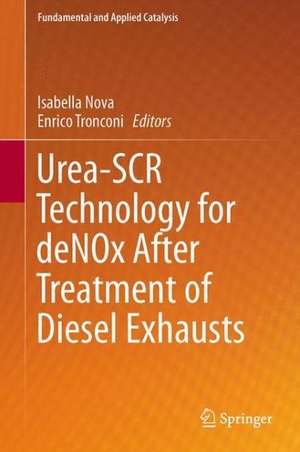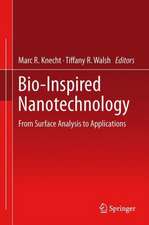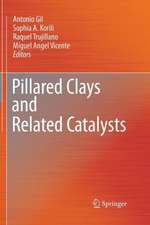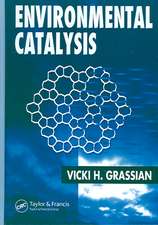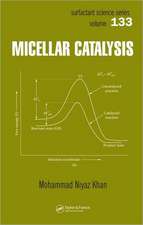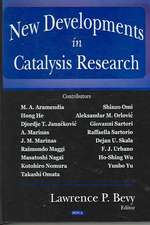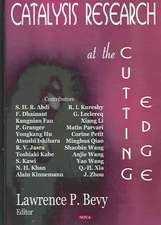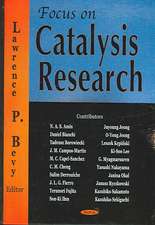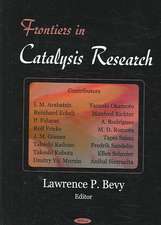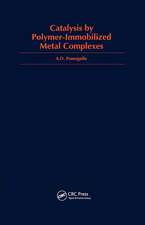Urea-SCR Technology for deNOx After Treatment of Diesel Exhausts: Fundamental and Applied Catalysis
Editat de Isabella Nova, Enrico Tronconien Limba Engleză Hardback – 15 mar 2014
selective catalytic reduction of NOx by ammonia/urea. The book starts with
an illustration of the technology in the framework of the current context (legislation,
market, system configurations), covers the fundamental aspects of the SCR process
(catalysts, chemistry, mechanism, kinetics) and analyzes its application to useful topics
such as modeling of full scale monolith catalysts, control aspects, ammonia injections
systems and integration with other devices for combined removal of pollutants.
| Toate formatele și edițiile | Preț | Express |
|---|---|---|
| Paperback (1) | 1019.79 lei 6-8 săpt. | |
| Springer – 3 sep 2016 | 1019.79 lei 6-8 săpt. | |
| Hardback (1) | 1405.90 lei 6-8 săpt. | |
| Springer – 15 mar 2014 | 1405.90 lei 6-8 săpt. |
Preț: 1405.90 lei
Preț vechi: 1714.50 lei
-18% Nou
Puncte Express: 2109
Preț estimativ în valută:
269.05€ • 292.15$ • 226.00£
269.05€ • 292.15$ • 226.00£
Carte tipărită la comandă
Livrare economică 22 aprilie-06 mai
Preluare comenzi: 021 569.72.76
Specificații
ISBN-13: 9781489980700
ISBN-10: 1489980709
Pagini: 736
Ilustrații: XX, 716 p. 411 illus., 292 illus. in color.
Dimensiuni: 155 x 235 x 45 mm
Greutate: 1.16 kg
Ediția:2014
Editura: Springer
Colecția Springer
Seria Fundamental and Applied Catalysis
Locul publicării:New York, NY, United States
ISBN-10: 1489980709
Pagini: 736
Ilustrații: XX, 716 p. 411 illus., 292 illus. in color.
Dimensiuni: 155 x 235 x 45 mm
Greutate: 1.16 kg
Ediția:2014
Editura: Springer
Colecția Springer
Seria Fundamental and Applied Catalysis
Locul publicării:New York, NY, United States
Public țintă
Professional/practitionerCuprins
Selective Catalytic Reduction and Related Technologies for Mobile Applications.- Selective Catalytic Reduction Technology for Off-Highway (Large Diesel Engine) Applications.- Vanadia-based Catalysts for Mobile Selective Catalytic Reduction.- Fe-zeolite Catalysts for NH3-SCR of NOx: Functionality, Durability and Deactivation Mechanisms.- Cu/zeolite SCR Catalysts for Automotive Diesel NOx Emission Control.- Low-temperature NH3-SCR of NOx over Zeolites and Metal Oxides Based Catalysts and Recent Developments of H2 SCR.- Active Sites for Selective Catalytic Reduction.- Mechanistic Aspects of the NO-NH3-O2 Reacting System.- The Role of NO2 in the NH3-SCR Catalytic Chemistry.- Kinetics of NH3-SCR Reactions over V2O5 – WO3/TiO2 Catalysts.- Lean NOx Reduction by NH3 on Fe-Exchanged Zeolite and Layered Fe/Cu Zeolite Catalysts.- Kinetic Modeling of Ammonia Selective Catalytic Reduction for Cu-Zeolite Catalysts.- Reactor Models for Flow-through and Wall-flow Converters.- Diesel Engine SCR Systems: Modeling, Measurements and Control.- DEF Systems and After treatment Architecture Considerations.- Ammonia storage and release in SCR systems for mobile applications.- Modelling the gas flow process inside exhaust systems: one-dimensional and multi-dimensional approaches.- Dual-layer Ammonia Slip Catalysts for automotive SCR exhaust gas after treatment: an experimental and modelling study.- NSR-SCR combined systems: production and use of ammonia.- Integration of SCR Functionality into Diesel Particulate Filters.- Development of the 2010 Ford Diesel Truck Catalyst System.- Model-based approaches to exhaust after treatment system development.
Recenzii
“It covers a spectrum of topics beyond just the needs of SCR researchers: It also provides plenty of easy-to-digest, well-written, thorough information and insights for anybody seriously active in NOx reduction … . this book is a must for any library, organization or individual having a primary or even a secondary interest in Diesel NOx emission reduction, heterogeneous catalysis in Diesel emission mitigation or in related aspects … .” (Mansour Masoudi, Emission Control Science and Technology, Vol. 1, 2015)
“An important up-to-date survey of the state of SCR science and technology that over recent years has undergone tremendous advances. … will be of value to researchers working in the SCR area as well as a reference for students in chemistry, catalysis and chemical engineering. The editors are to be congratulated for bringing together so many eminent contributors and completing such a major endeavour. This book should therefore be made available in academic and industrial research libraries … .” (Martyn V. Twigg, Johnson Matthey Technology Review, Vol. 59 (3), 2015)
“An important up-to-date survey of the state of SCR science and technology that over recent years has undergone tremendous advances. … will be of value to researchers working in the SCR area as well as a reference for students in chemistry, catalysis and chemical engineering. The editors are to be congratulated for bringing together so many eminent contributors and completing such a major endeavour. This book should therefore be made available in academic and industrial research libraries … .” (Martyn V. Twigg, Johnson Matthey Technology Review, Vol. 59 (3), 2015)
Notă biografică
Isabella Nova is Associate Professor of Chemical Engineering at the Department of Energy, Politecnico of Milan, Italy. Nova’s research work is focused on the study of environmental catalytic processes, including Selective Catalytic Reduction of NOx by NH3 and Diesel Particulate filters for the removal of soot and on new processes for the production of clean energy, such as the photocatalytic water splitting. She has co-authored over 100 publications on national and international journals in the fields of Chemical Reaction Engineering and Heterogeneous Catalysis and three national and international patents.
Enrico Tronconi is Full Professor of Chemical Engineering at Politecnico di Milano, Italy. His main research interests are in the area of Catalytic Reaction Engineering, with emphasis on industrial chemical processes for energy conversion and for environmental protection. His most recent work is focused on DeNOx after treatment technologies for vehicles, as well as on fundamental and engineering aspects concerning the development of novel structured catalysts and reactors. Tronconi has authored or co-authored over 180 scientific publications in international journals and is the inventor of 10 patents.
Enrico Tronconi is Full Professor of Chemical Engineering at Politecnico di Milano, Italy. His main research interests are in the area of Catalytic Reaction Engineering, with emphasis on industrial chemical processes for energy conversion and for environmental protection. His most recent work is focused on DeNOx after treatment technologies for vehicles, as well as on fundamental and engineering aspects concerning the development of novel structured catalysts and reactors. Tronconi has authored or co-authored over 180 scientific publications in international journals and is the inventor of 10 patents.
Textul de pe ultima copertă
Urea-SCR Technology for deNOx After Treatment of Diesel Exhausts presents a complete overview of the selective catalytic reduction of NOx by ammonia/urea. The book starts with an illustration of the technology in the framework of the current context (legislation, market, system configurations), covers the fundamental aspects of the SCR process (catalysts, chemistry, mechanism, kinetics) and analyzes its application to useful topics such as modeling of full scale monolith catalysts, control aspects, ammonia injections systems and integration with other devices for combined removal of pollutants.
Caracteristici
The first treatment in book format of Selective Catalytic Reduction (SCR) Equally interesting to professionals and to academics Contains contributions from the leaders in diesel exhaust abatement Includes supplementary material: sn.pub/extras
